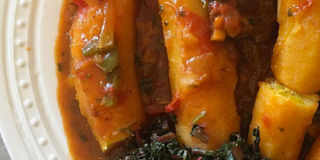Prime
Get to know what katogo is

Katogo is a staple you will not miss at any Ugandan restaurant.
The Ugandans call it katogo, while the French call it pot au feu (literally meaning pot on fire), in Spain they would refer to it as ‘Ollas” while the Mongolian grill is certainly a variation on the theme of katogo though in this case they use a combination of meats mixed with vegetables.
It is a safe bet that if there is one common dish that is universal to Uganda, it would be katogo. Originally, conceived as poor man’s dish, it is the quintessence of Ugandan proletariat cuisine and has remained the mainstay for the Ugandan breakfast, especially in the Buganda and Western Uganda.
The word katogo literally means a ‘mélange’ or mixture of ingredients with one absolute must have; matooke. The process of cooking is done in the manner of braising in other words a combination of stewing and pot roasting.
While no one has an exact chronology as to when Ugandans started cooking katogo, what is not in doubt is that as long as matooke has been around so has katogo. For that matter, the preparation of steamed matooke is a long and drawn out process that takes up a lot of energy in the form of firewood or charcoal.
How it came to be
Necessity being the mother of invention, some smart person way back in time had the wisdom to realise that boiled matooke takes a short time to cook and though not considered anywhere near as good as the lovingly steamed and ‘amanyige’ mashed type, still has the taste and flavour.
My view is originally, the less privileged simply boiled whole matooke ‘fingers’ and added salt and ghee and created a meal that would sustain them during the day. A healthy (minimises the unwanted and dreaded polyunsaturated oils used in frying meats) and practical approach, at the same time the ghee and salt greatly help in bringing out the full flavour of the matooke.
Ingredients
Interestingly, during ancient times when our kings reigned and held court, it was common practice to slaughter all manner of animals the most typical being the cow.
Inasmuch as the king had the pick of the roost, one would hardly have expected him to have anything to do with the entrails and so it was left for the hangers on and couturiers to devise the best way of making the most of what the French have come to regard as a delicacy.
The Baganda, being clever and resourceful somehow managed to come up with the excellent combination of offals and matooke.
However, today it is a pot pourri, anything goes.
Gone are the days when the hoi polloi could be assured of banking Shs1, 000 for a meal of katogo and tea. Still given today’s inflation the price has doubled and even at Shs3,000, with a mug of tea it continues to be a best seller.
Last but not least, even some of the better high end eateries feature katogo on the menu and for a cool Shs 20,000 you are assured of a wonderful plate of katogo.




